Nexus 6 vs iPhone 6 Plus camera comparison: where Google's smartphone shines and where it lags behind the iPhone
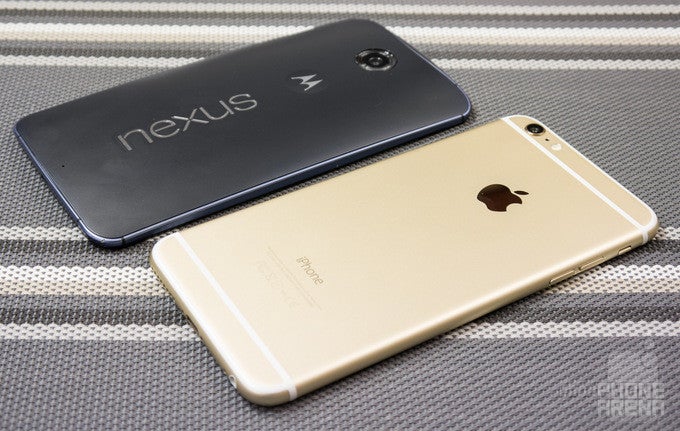
Not long ago, we did a camera comparison between two highly-acclaimed smartphones, namely the Nexus 6 and the iPhone 6 Plus. But you, guys, didn't know that at the time since the comparison was of the blind variety. In other words, we only presented a series of photo samples and asked you to vote for the camera which you liked better. Once all votes were in it became clear that Google's handset had won the race. And not by a hair. In fact, the Nexus 6 was favored by more than three quarters of all who voted, while the iPhone 6 Plus, despite known for its great camera, received less than a quarter of all votes.
So, is the Google Nexus 6 the next yardstick and new king of cameraphones? Not really. Is it better than the iPhone 6 Plus? Well, it depends. We continued our extensive testing between the two phones' cameras and concluded that the Nexus 6 does have the potential to stand out under the right conditions. In certain cases, however, it can't quite beat Apple's biggest iPhone to date. We'll elaborate on the matter below as we comment on the photo samples in this comparison. Note that they've all been taken using the cameras' default settings, with HDR off, and flash on only where specified.
Scene 1 - performance in broad daylight
We took a shot of this scene on a sunny afternoon, when the sun was nearing the horizon. Judging the two cameras' performance, at least in this case, is not easy as it is a matter of picking between faithful reproduction and what looks pleasing to the eye. To be more specific, the image from the Nexus 6 comes closer to reality in terms of colors and overall presentation, whereas the iPhone 6 Plus has captured an overly-warm, yet more captivating photo.
Zooming in on the two photos reveals that Google's smartphone has produced a sharper image. But a sharper photo, although it might look better that way, isn't a necessarily a more detailed photo. As a matter of fact, we took the iPhone's photo and manually increased its sharpness – the result was an image looking almost exactly like the Nexus 6's in terms of details. All in all, the Nexus 6 took only a marginally more detailed shot of this scene despite its considerable advantage in megapixel count (13MP vs the iPhone's 8MP).
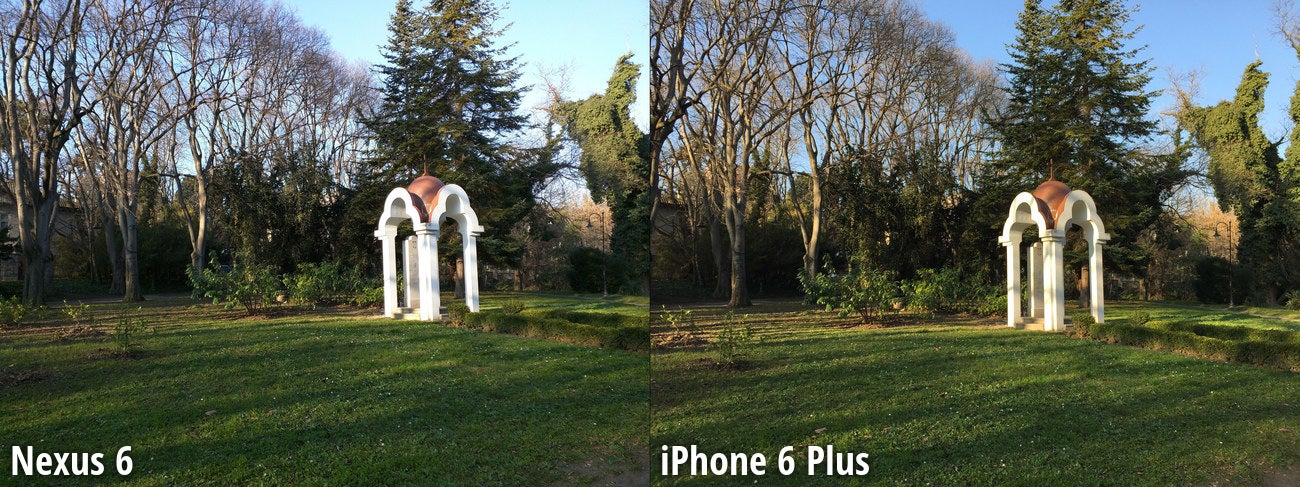
Side-by-side preview
Scene 2 - outdoor color accuracy
The iPhone's tendency to produce warm images is even more obvious in this scene, where the rocks and foliage, illuminated by the sun's already yellowish glow, appear unnatural with their exaggerated warmth. As for the Nexus 6, its image is a much closer representation of what our eyes could see at that moment. Also, the latter has produced sharper details, as it did in the previous scene.

Side-by-side preview
Scene 3 - details and color fidelity in daytime photos
Here's another example of how the Nexus 6 and the iPhone 6 Plus approach color reproduction differently. Again, the former sticks closely to reality, while the latter delivers much warmer color tones. Yet despite its imperfections, the image from the iPhone easily grabs the attention with its vividness, while the Nexus's photo is somewhat dull in appearance.
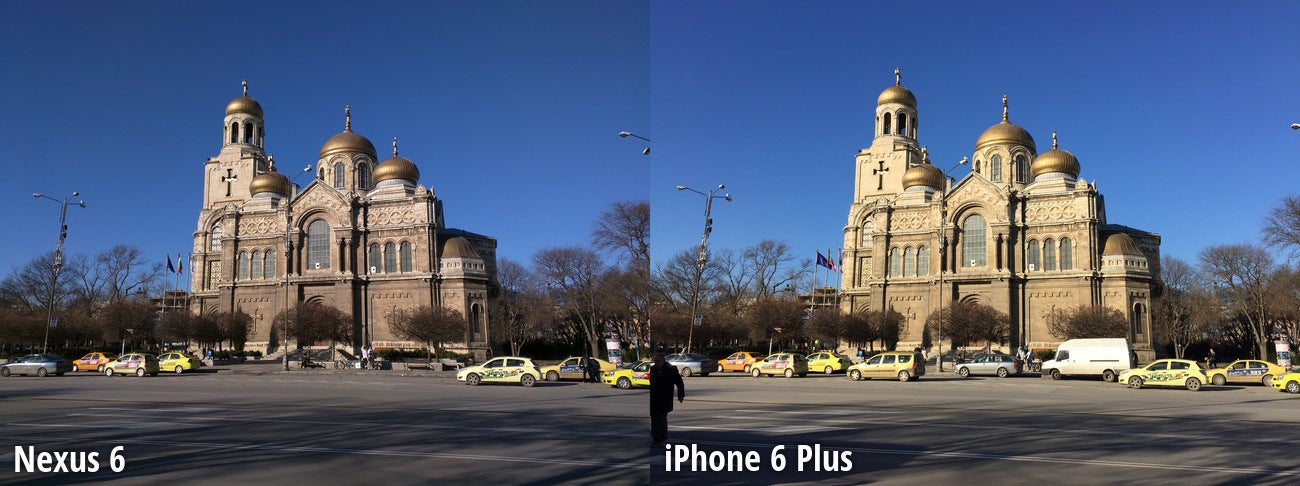
Side-by-side preview
Scene 4 - Colors and exposure
Now let's take a look at a scene with a bit more color variety in it. Here's where the iPhone's camera shines with its ability to not overexpose brightly-lit portions of the frame – take a look at the flowers' petals in the first close-up to see what we mean. Again, the photo taken with the Nexus 6 is noticeably sharper.
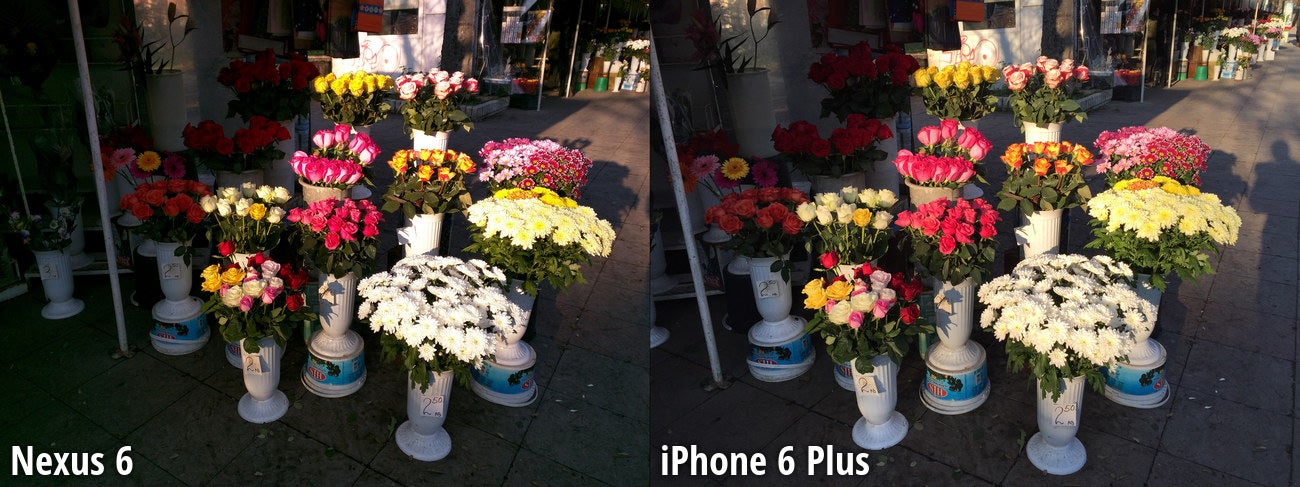
Side-by-side preview
Scene 5 - Indoor studio test
This is a test image we take in a studio with any smartphone that lands in our office for review. What you see photographed is a poster printed with great precision on high-quality canvas. We ensure the frame's accurate illumination by measuring and controlling the amount of light falling at several key points of the image. Phones are mounted on a tripod for this test. When taken under these conditions, the Nexus 6 and the iPhone 6 Plus produce nearly identical results. The amount of details and the presence of digital noise stand, more or less, at the same level for both images.

Side-by-side preview
Scene 6 - ISO 12233 chart
These images were also produced using the procedure described above. What we have here is an ISO 12233 chart, which is used for detecting a variety of camera distortions. That the Nexus 6 adds a hint of sharpness to its images is clear to see, whereas the iPhone 6 Plus retains a neutral sharpness level. About the whole sharpness thing, it makes images seem more detailed, and we're sure that some people might like their photos better that way. But a silver bullet it is not. The extra sharpness is more of a double-edged sword, making some images more pleasing to the eye, while rendering others unnatural. Scenes of high contrast, for example, may end up looking plain weird. We must also note that the photo from Google's smartphone contains more artifacts due to jpeg compression.
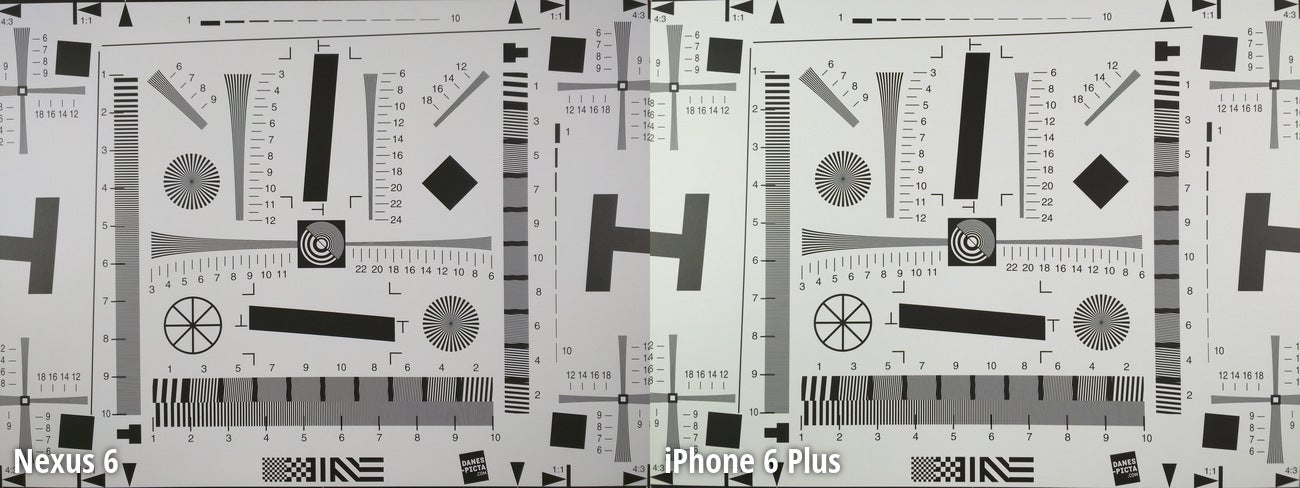
Side-by-side preview
Scene 7 - Flash performance
To test the low-light performance of the two phones, we shot this indoor scene in complete darkness. The results are greatly in favor of the iPhone 6 Plus, as we're sure you'll agree. Its image is well exposed, with good details and plenty of illumination provided by its flash. The Nexus 6, on the other hand, produced a darker image with poorer detail quality. On top of that, the odd dual-LED flash configuration on Google's smartphone produces horribly-looking "twin" shadows behind objects at a specific distance from the camera.
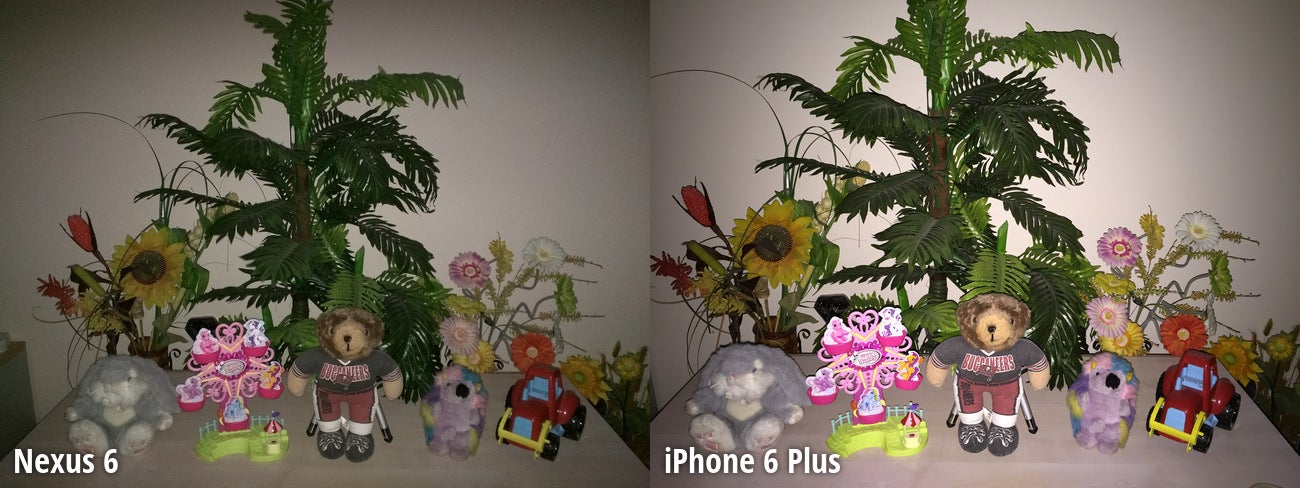
Side-by-side preview
Scene 8 - Details and noise in indoor images
We shot these two images in our office under a fair amount of artificial and natural lighting. Overall, the iPhone 6 Plus's camera did a slightly better job at it – its photo contains clearer details despite the lower resolution of its sensor. As for the Nexus 6, we see a greater amount of digital noise its image. Also, the amount of distortion seen in the tree on the right is unacceptable.
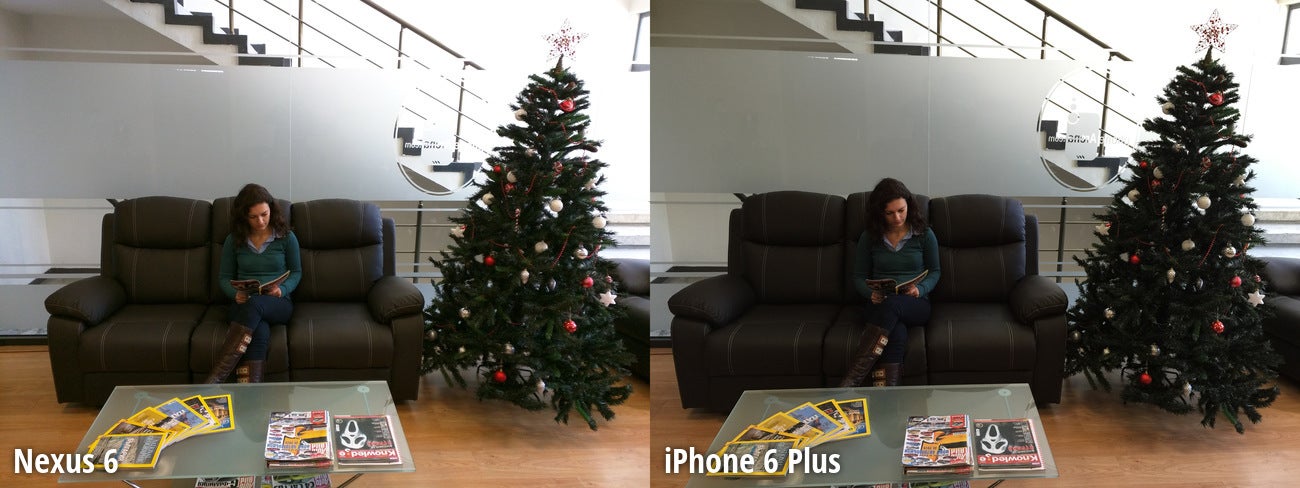
Side-by-side preview
Scene 9 - Low-light performance
It looks like taking photos in low light is a discipline the Nexus 6 isn't very good at. Or at least it isn't any better than the iPhone 6 Plus. Here's a photo taken at night, with a couple of small light bulbs acting as light sources. Google's smartphone fails at capturing fine details, as it becomes clear once we zoom in. The iPhone 6, however, manages to capture a fine, detailed image with less digital noise in it. The latter's warm color tones are present in this sample as well, but they do contribute to creating a more visually pleasing image.
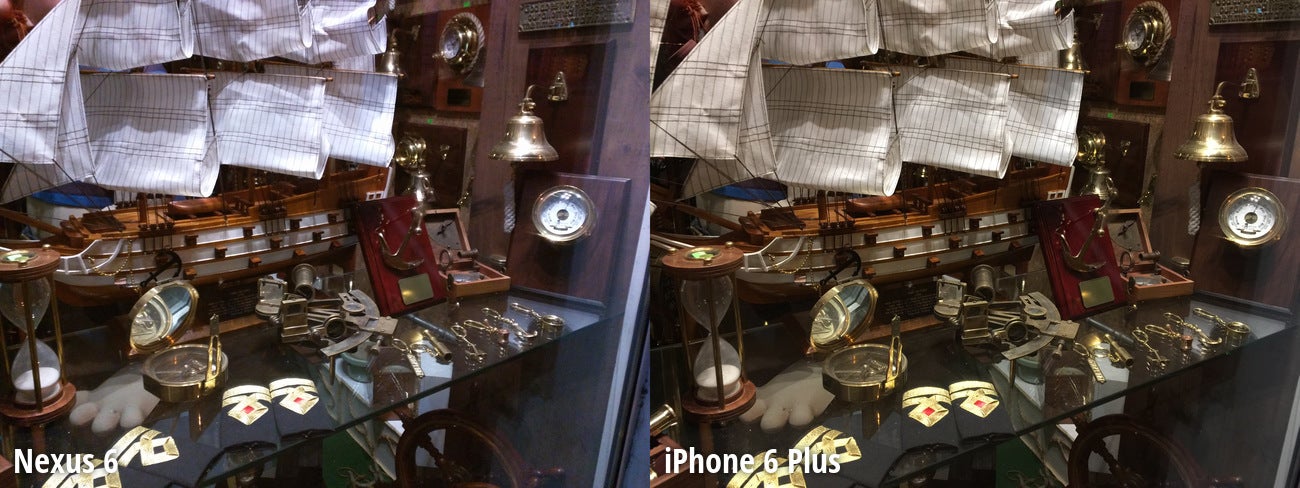
Side-by-side preview
Scene 10 - Night scenery
Again, the Nexus 6 is lagging behind the iPhone 6 Plus by a significant margin, but given the quality of the previous shots, we kind of expected that. Google's smartphone produced a slightly blurry image despite the fact that it boasts optical image stabilization. (Before you blame the photographer, do keep in mind that I took the shot three times – this was arguably the best sample among them.) In contrast, the photo from the iPhone 6 Plus is much pleasant to look at with its warm colors and rich details.
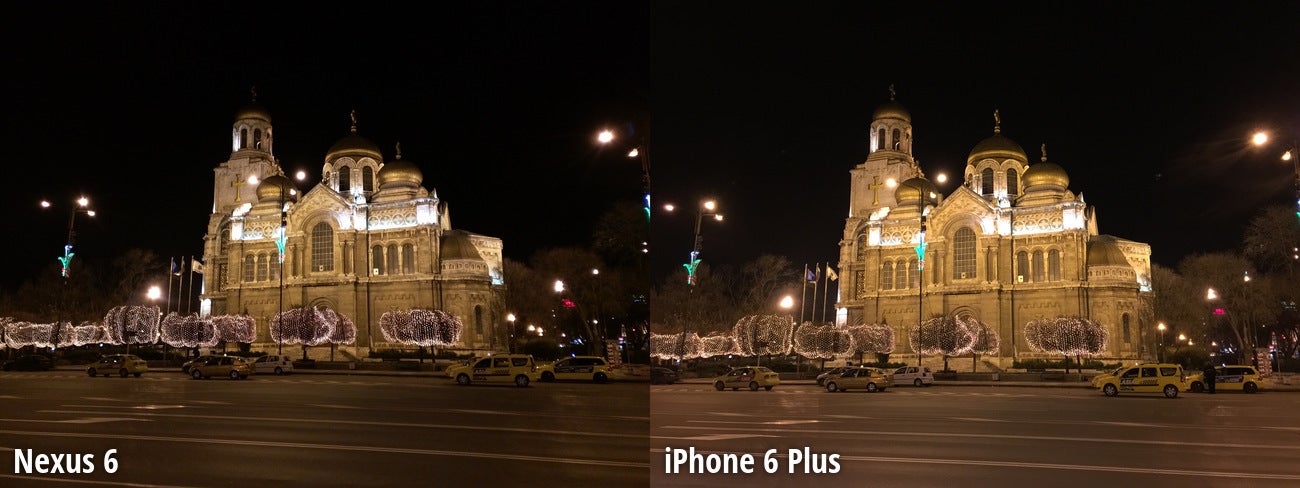
Side-by-side preview
Conclusion
Motorola, the maker of the Nexus 6, has equipped Google's smartphone with a great camera – a camera that rivals the iPhone 6 Plus with its quality photos. And we think many of our readers would agree with that statement, given the voting results from our blind camera comparison. But the Nexus 6 excels only under certain conditions. Although it shoots terrific photos in broad daylight, the quality of its images drops sharply when light is of moderate to low amounts. Moreover, we don't consider ourselves fans of its sharpened images. Sure, they may seem more detailed, and a fraction of users would surely prefer them looking that way, but we don't think a camera should attempt to create details where they aren't present.
As for the iPhone 6 Plus, it is an excellent performer in low-light environments. It shoots fantastic photos in daytime as well. But our opinion on its color reproduction is mixed – on one hand, the warmth added to images creates a captivating effect, but it isn't exactly what we'd call natural. As a matter of fact, its presence may totally spoil an otherwise pleasant image, like what happened in the second scene we presented above.
At the end of the day, the camera on the Nexus 6 is a splendid one, but it lacks the versatility of the one on the iPhone 6 Plus. In other words, the iPhone would take a good picture regadless of the shooting environment, whereas the Nexus shines only when given optimum conditions. That's what makes the iPhone 6 Plus one of the best cameras around.
Follow us on Google News




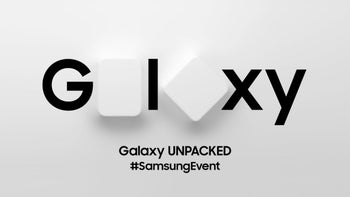
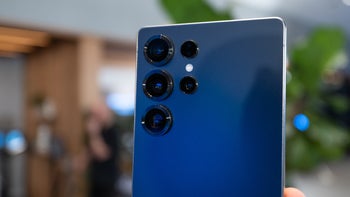





Things that are NOT allowed:
To help keep our community safe and free from spam, we apply temporary limits to newly created accounts: